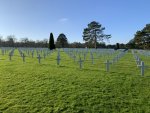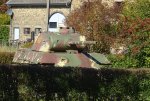As it was 78 years ago, it is a cold foggy morning in Belgium. -2 degrees C outside.
The Attack in the Losheim Gap
The shock companies of the 18th Volksgrenadier Division began to move toward the American cavalry positions about 0400 on 16 December. [start of page 145] An hour later the main strength of the two attacking regiments followed, the German 294th Infantry Regiment advancing toward Weckerath and the Our valley, the 294th heading for Roth and Kobscheid. Supporting artillery, mortars, and Werfers opened fire over the heads of the German infantry shortly after 0830. (Actually the first concentrations to arouse the Americans were fired as part of the Sixth Panzer Army artillery preparation prior to H-hour and landed in the northern part of the 14th Cavalry zone). Roth and Kobscheid, closest to the enemy jump-off positions, received only one battery salvo; apparently the German infantry were already around the villages. When day broke, cloudy and drizzling, the assault force moving between Weckerath and Roth was well on its way to the commanding crossroads village of Auw. Visibility was so poor, the American village positions so dispersed, that the cavalrymen for some time did not detect nor engage the infantry moving past. (The Germans, having received no fire, first suspected that the main American line had been moved back to the Our River.) Furthermore, predawn attacks on Roth and Kobscheid had occupied the attention of the troopers. At Roth a company of grenadiers was checked by shellfire. The attackers at Kobscheid actually got inside the cavalry defense, but nearly forty were captured.
Before dawn none of the village garrisons in the southern sector had been seriously menaced. The effects of the enemy penetrations, however, became apparent soon after daylight. At 0830 a message from Roth reported that the Germans were inside the village, that a tank seventy-five yards from the command post was "belting us with direct fire." Light tanks, dispatched from Manderfeld, hurried to give aid but were stopped cold by fire from Auw, some 3,500 yards to the west, which was occupied by the Germans. Nothing more was heard from Roth. The remainder of Troop A, in Kobscheid, also was cut off; by 0900 the attackers had established a hold inside the village. Weckerath, which lay to one side of the German advance on Auw, was hit by elements of the 294th. Here the 3d Platoon of Troop C was located east of the village in a small patch of woods on the road to Krewinkel, well dug in and protected by barbed wire on all sides. The first German assault was checked by mortars and machine guns, reinforced by accurate artillery fire. Two enemy companies, however, swept around the wood and converged on the village, where some twenty men of Troop C headquarters held them at bay with bullet fire. A platoon of American light tanks arrived from Manderfeld shortly after 0930, appearing just in time to engage groups of enemy infantry infiltrating the eastern edge of the village. At 1100 observers at Weckerath saw an enemy column moving from Roth in the direction of Auw. They counted fifteen "tanks"-probably a battalion of assault guns-and at least one battalion of foot troops, marching intermixed with the assault guns. Artillery fire was directed onto the column, with but little effect. The Germans pressed on to the west. In the northern sector of the 14th Cavalry Group fortune had treated the defenders with mixed favor during the morning. The German force committed here consisted of a reinforced regiment of the 3d Parachute Division (it will be [146] recalled that the boundary between the Fifth and Sixth Panzer Armies ran just south of Krewinkel and Manderfeld) attacking initially without the support of heavy weapons. The 3d Parachute Division axis cut straight through the northern cavalry sector, then angled northwest in the direction of Faymonville, the division advancing as the left flank of the I SS Panzer Corps. At Krewinkel, the most advanced American post in the area, the 2d Platoon of Troop C and a reconnaissance platoon of Company A, 820th Tank Destroyer Battalion, occupied a position from which excellent observation and fields of fire covered all approaches to the village from the east. An hour before dawn a German shock company boldly approached the village in column of fours. The troopers held their fire until the enemy infantry were within twenty yards of the outer strands of wire-then cut loose. The column disintegrated, but the assault was quickly resumed in more open order and shortly the Germans were in the village streets. At one point half the village was in German hands, but eventually the defenders got the upper hand and the enemy withdrew.
One of the last to leave shouted in English, "Take a ten minute break. We'll be back." An exasperated trooper hastened to assure him profanely, "we'll still be here."
The Attack in the Losheim Gap
The shock companies of the 18th Volksgrenadier Division began to move toward the American cavalry positions about 0400 on 16 December. [start of page 145] An hour later the main strength of the two attacking regiments followed, the German 294th Infantry Regiment advancing toward Weckerath and the Our valley, the 294th heading for Roth and Kobscheid. Supporting artillery, mortars, and Werfers opened fire over the heads of the German infantry shortly after 0830. (Actually the first concentrations to arouse the Americans were fired as part of the Sixth Panzer Army artillery preparation prior to H-hour and landed in the northern part of the 14th Cavalry zone). Roth and Kobscheid, closest to the enemy jump-off positions, received only one battery salvo; apparently the German infantry were already around the villages. When day broke, cloudy and drizzling, the assault force moving between Weckerath and Roth was well on its way to the commanding crossroads village of Auw. Visibility was so poor, the American village positions so dispersed, that the cavalrymen for some time did not detect nor engage the infantry moving past. (The Germans, having received no fire, first suspected that the main American line had been moved back to the Our River.) Furthermore, predawn attacks on Roth and Kobscheid had occupied the attention of the troopers. At Roth a company of grenadiers was checked by shellfire. The attackers at Kobscheid actually got inside the cavalry defense, but nearly forty were captured.
Before dawn none of the village garrisons in the southern sector had been seriously menaced. The effects of the enemy penetrations, however, became apparent soon after daylight. At 0830 a message from Roth reported that the Germans were inside the village, that a tank seventy-five yards from the command post was "belting us with direct fire." Light tanks, dispatched from Manderfeld, hurried to give aid but were stopped cold by fire from Auw, some 3,500 yards to the west, which was occupied by the Germans. Nothing more was heard from Roth. The remainder of Troop A, in Kobscheid, also was cut off; by 0900 the attackers had established a hold inside the village. Weckerath, which lay to one side of the German advance on Auw, was hit by elements of the 294th. Here the 3d Platoon of Troop C was located east of the village in a small patch of woods on the road to Krewinkel, well dug in and protected by barbed wire on all sides. The first German assault was checked by mortars and machine guns, reinforced by accurate artillery fire. Two enemy companies, however, swept around the wood and converged on the village, where some twenty men of Troop C headquarters held them at bay with bullet fire. A platoon of American light tanks arrived from Manderfeld shortly after 0930, appearing just in time to engage groups of enemy infantry infiltrating the eastern edge of the village. At 1100 observers at Weckerath saw an enemy column moving from Roth in the direction of Auw. They counted fifteen "tanks"-probably a battalion of assault guns-and at least one battalion of foot troops, marching intermixed with the assault guns. Artillery fire was directed onto the column, with but little effect. The Germans pressed on to the west. In the northern sector of the 14th Cavalry Group fortune had treated the defenders with mixed favor during the morning. The German force committed here consisted of a reinforced regiment of the 3d Parachute Division (it will be [146] recalled that the boundary between the Fifth and Sixth Panzer Armies ran just south of Krewinkel and Manderfeld) attacking initially without the support of heavy weapons. The 3d Parachute Division axis cut straight through the northern cavalry sector, then angled northwest in the direction of Faymonville, the division advancing as the left flank of the I SS Panzer Corps. At Krewinkel, the most advanced American post in the area, the 2d Platoon of Troop C and a reconnaissance platoon of Company A, 820th Tank Destroyer Battalion, occupied a position from which excellent observation and fields of fire covered all approaches to the village from the east. An hour before dawn a German shock company boldly approached the village in column of fours. The troopers held their fire until the enemy infantry were within twenty yards of the outer strands of wire-then cut loose. The column disintegrated, but the assault was quickly resumed in more open order and shortly the Germans were in the village streets. At one point half the village was in German hands, but eventually the defenders got the upper hand and the enemy withdrew.
One of the last to leave shouted in English, "Take a ten minute break. We'll be back." An exasperated trooper hastened to assure him profanely, "we'll still be here."









